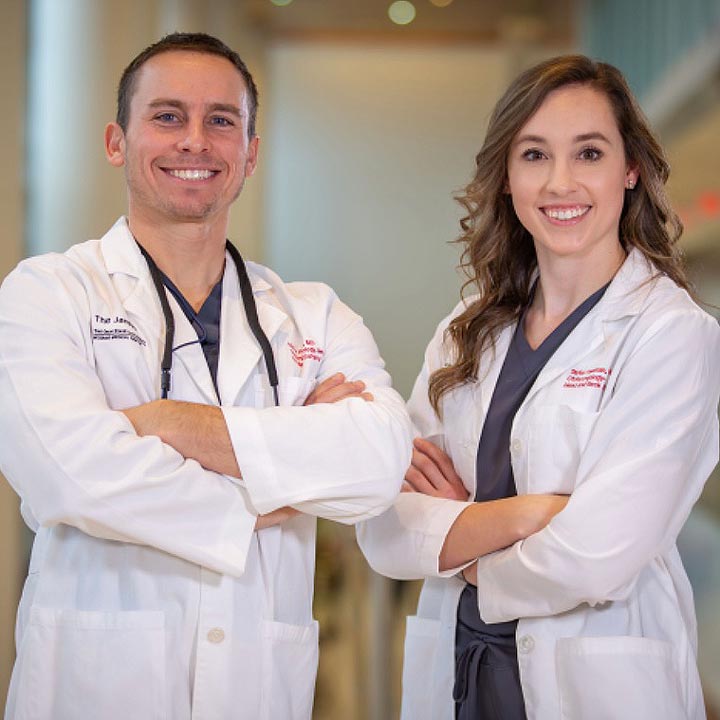 At The Ohio State University Comprehensive Cancer Center – Arthur G. James Cancer Hospital and Richard J. Solove Research Institute (OSUCCC – James), an innovative initiative is reshaping postoperative care for people with head and neck cancer. Recognizing an opportunity to enhance care and reduce hospital stays, Taylor Freeman, MD, a resident in the Ohio State Department of Otolaryngology – Head and Neck Surgery, and Nolan Seim, MD, MBA, surgical oncologist and associate clinical professor in the Department of Otolaryngology – Head and Neck Surgery, developed an innovative educational video to empower patients to remove their surgical drains at home safely.
At The Ohio State University Comprehensive Cancer Center – Arthur G. James Cancer Hospital and Richard J. Solove Research Institute (OSUCCC – James), an innovative initiative is reshaping postoperative care for people with head and neck cancer. Recognizing an opportunity to enhance care and reduce hospital stays, Taylor Freeman, MD, a resident in the Ohio State Department of Otolaryngology – Head and Neck Surgery, and Nolan Seim, MD, MBA, surgical oncologist and associate clinical professor in the Department of Otolaryngology – Head and Neck Surgery, developed an innovative educational video to empower patients to remove their surgical drains at home safely.
The project addresses a critical aspect of recovery following complex head and neck cancer surgeries. Effective surgical drain management reduces complications such as seroma formation, infection and delayed wound healing. However, patients and caregivers often feel overwhelmed despite receiving in-clinic instructions.
Empowering patients with clear, high-quality educational tools that complement their in-person training is essential to improve outcomes, according to Dr. Seim. “Proper drain management is pivotal, not just for the immediate postoperative period, but also for instilling confidence in patients as they transition to at-home care.”
The team secured funding to create a professionally produced video designed with input from both surgical teams and patients. The video provides a step-by-step visual guide that covers hand hygiene, drain removal techniques and early signs of complications.
“We know that patient understanding and adherence to postoperative care directly correlate with complication rates,” Dr. Freeman says. “By creating a video that patients can access as often as they need to, we’re reinforcing their training and helping mitigate preventable issues.”
The initiative also expands access to care by reducing unnecessary hospital visits and saves patients the cost and hassle of additional postoperative visits. This is especially beneficial for patients traveling long distances for treatment. “It aligns with [the university’s] overall mission of access to care,” Dr. Seim says.
The initial version, created during the COVID-19 pandemic, featured a manikin to demonstrate drain removal. But after positive patient feedback, the physicians partnered with a marketing agency to produce a more realistic version with real patients.
Released earlier this year, the new video, available in English and Spanish, addresses common questions, such as where to cut the suture. It also features real patients undergoing actual drain removals, which makes the content both authentic and relatable. It’s the centerpiece of a comprehensive educational toolkit that includes handouts and 3D-printed models.
Since its release, the program has achieved impressive results. More than 500 patients have successfully removed their surgical drains at home, with a success rate exceeding 95%. This has significantly decreased hospital stays and freed up clinic resources, which has enabled the ENT department to accommodate more follow-up and new patient appointments.
“We spend a lot of time with the patient beforehand so they’re comfortable with the procedure,” Dr. Freeman says, “but they always have a choice to come in to have us do it.” Most patients choose the at-home program, though. “Patients really do like taking some ownership in their care,” she says. “It’s exciting when they come back, and they tell you about how they did it. They’re very proud.”
The team is exploring opportunities to expand this approach to other procedures, such as tracheotomies and laryngectomies. Fully funded for the next three years through a patient care innovation award, the initiative underscores how leadership at the Ohio State Wexner Medical Center integrates innovation with clinical expertise to enhance patient outcomes.
The project’s success has garnered national attention. The team, along with Rishabh Sethia, MD, pediatric otolaryngologist at Nationwide Children's Hospital and assistant clinical professor of Otolaryngology – Head and Neck Surgery at the Ohio State College of Medicine, published their findings in The Laryngoscope and has presented this work at national conferences.
“Our goal is to share this effective protocol with other head and neck teams across the country,” Dr. Seim says. By addressing an often-overlooked aspect of postoperative care, the Ohio State Wexner Medical Center sets a new standard for patient education and empowerment, and reaffirms its commitment to innovation and excellence in otolaryngology care.
